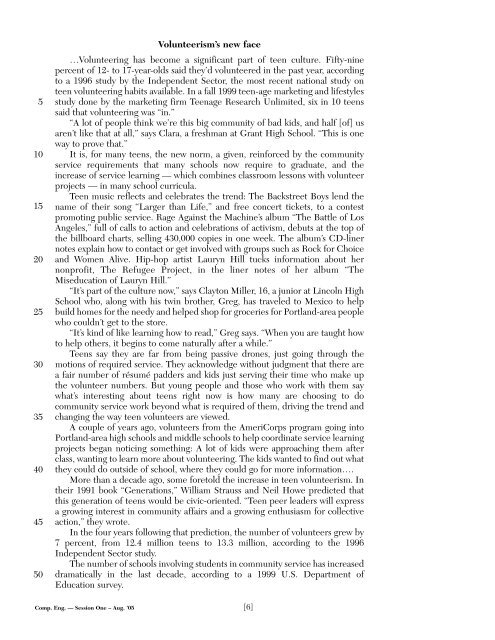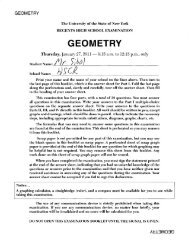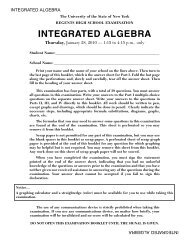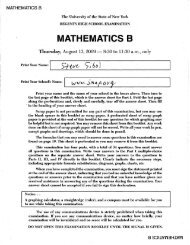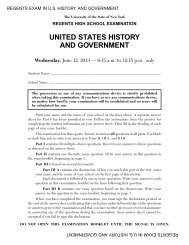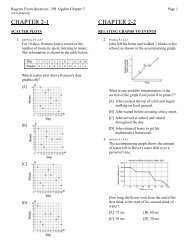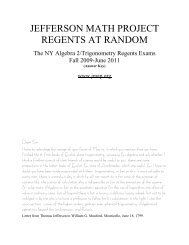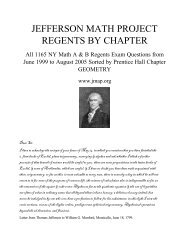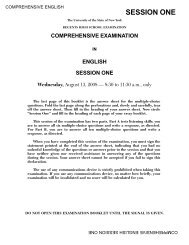SESSION ONE - JMap
SESSION ONE - JMap
SESSION ONE - JMap
You also want an ePaper? Increase the reach of your titles
YUMPU automatically turns print PDFs into web optimized ePapers that Google loves.
5<br />
10<br />
15<br />
20<br />
25<br />
30<br />
35<br />
40<br />
45<br />
50<br />
Volunteerism’s new face<br />
…Volunteering has become a significant part of teen culture. Fifty-nine<br />
percent of 12- to 17-year-olds said they’d volunteered in the past year, according<br />
to a 1996 study by the Independent Sector, the most recent national study on<br />
teen volunteering habits available. In a fall 1999 teen-age marketing and lifestyles<br />
study done by the marketing firm Teenage Research Unlimited, six in 10 teens<br />
said that volunteering was “in.”<br />
“A lot of people think we’re this big community of bad kids, and half [of] us<br />
aren’t like that at all,” says Clara, a freshman at Grant High School. “This is one<br />
way to prove that.”<br />
It is, for many teens, the new norm, a given, reinforced by the community<br />
service requirements that many schools now require to graduate, and the<br />
increase of service learning — which combines classroom lessons with volunteer<br />
projects — in many school curricula.<br />
Teen music reflects and celebrates the trend: The Backstreet Boys lend the<br />
name of their song “Larger than Life,” and free concert tickets, to a contest<br />
promoting public service. Rage Against the Machine’s album “The Battle of Los<br />
Angeles,” full of calls to action and celebrations of activism, debuts at the top of<br />
the billboard charts, selling 430,000 copies in one week. The album’s CD-liner<br />
notes explain how to contact or get involved with groups such as Rock for Choice<br />
and Women Alive. Hip-hop artist Lauryn Hill tucks information about her<br />
nonprofit, The Refugee Project, in the liner notes of her album “The<br />
Miseducation of Lauryn Hill.”<br />
“It’s part of the culture now,” says Clayton Miller, 16, a junior at Lincoln High<br />
School who, along with his twin brother, Greg, has traveled to Mexico to help<br />
build homes for the needy and helped shop for groceries for Portland-area people<br />
who couldn’t get to the store.<br />
“It’s kind of like learning how to read,” Greg says. “When you are taught how<br />
to help others, it begins to come naturally after a while.”<br />
Teens say they are far from being passive drones, just going through the<br />
motions of required service. They acknowledge without judgment that there are<br />
a fair number of résumé padders and kids just serving their time who make up<br />
the volunteer numbers. But young people and those who work with them say<br />
what’s interesting about teens right now is how many are choosing to do<br />
community service work beyond what is required of them, driving the trend and<br />
changing the way teen volunteers are viewed.<br />
A couple of years ago, volunteers from the AmeriCorps program going into<br />
Portland-area high schools and middle schools to help coordinate service learning<br />
projects began noticing something: A lot of kids were approaching them after<br />
class, wanting to learn more about volunteering. The kids wanted to find out what<br />
they could do outside of school, where they could go for more information….<br />
More than a decade ago, some foretold the increase in teen volunteerism. In<br />
their 1991 book “Generations,” William Strauss and Neil Howe predicted that<br />
this generation of teens would be civic-oriented. “Teen peer leaders will express<br />
a growing interest in community affairs and a growing enthusiasm for collective<br />
action,” they wrote.<br />
In the four years following that prediction, the number of volunteers grew by<br />
7 percent, from 12.4 million teens to 13.3 million, according to the 1996<br />
Independent Sector study.<br />
The number of schools involving students in community service has increased<br />
dramatically in the last decade, according to a 1999 U.S. Department of<br />
Education survey.<br />
Comp. Eng. — Session One – Aug. ’05 [6]


